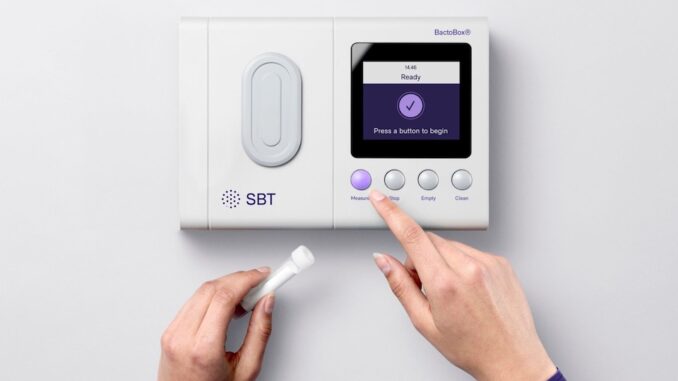

Gustav Skands
Gustav is the CEO of SBT Instruments. He co-founded the company in 2014 and has since dedicated his career to pioneering in the field of bacterial enumeration. Gustav holds a Master's degree in Physics from the Technical University of Denmark and has also completed an executive education program at Harvard Business School
Introduction
Until now, enumeration of bacteria by plate counts has been the de facto gold standard to evaluate the potency of live biotherapeutic and probiotic products. Nonetheless the method has clear limitations such as low throughput, lengthy-time-to-result, and low precision. Plate counts are exceedingly challenging for strictly anaerobic bacteria like C. minuta, and finally, plate counts are obviously unfit for characterization of postbiotic products that contain inactivated forms of bacteria.
Flow cytometry has been increasingly recognized as a promising alternative for bacterial enumeration, especially in live biotherapeutics where many bacteria are difficult to culture. Yet, traditional fluorescence flow cytometry systems are hindered by their high costs and complex workflows. To overcome these limitations, SBT Instruments has developed the BactoBox, a compact and commercially available device. This device features impedance flow cytometry, a novel technology that offers a practical solution to the challenges of traditional flow cytometry. Priced at approximately $10,000, BactoBox is an affordable, fast, and user-friendly solution. It employs a label-free technique, making it easier to standardize. A recent peer-reviewed study has shown that the results obtained with impedance flow cytometry in BactoBox are very similar to those achieved with conventional fluorescence flow cytometry techniques.
Membrane intactness is a proxy for viability
Enumeration of bacteria by plate counts is – in principle – an indirect method based on the premise that a viable bacterium will multiply on solid medium and form a colony that can be detected by the naked eye.
In contrast, flow cytometry directly identifies individual live and dead bacteria. This differentiation primarily hinges on assessing the integrity of the bacterial membrane, a critical component of all living organisms on Earth. In fluorescence flow cytometry a bacterium with an intact membrane will hinder uptake of propidium iodide (PI), while a total stain like thiazole orange can enter both live and dead cells. The count of live cells, or active fluorescent units (AFU), is determined by deducting the number of dead cells from the total count.
The technology embedded in BactoBox, impedance flow cytometry, also distinguishes bacteria based on their membrane status, but it does so based on their electrical properties. Simplified, bacteria with intact lipid membranes significantly impede electrical current, unlike those with compromised membranes.
Recent study demonstrates strong agreement between impedance and fluorescence flow cytometry
Impedance flow cytometry (impedance FC) and fluorescence flow cytometry (fluorescence FC) were recently compared head-to-head in a newly published, peer-reviewed ring test study. Various fluorescence FC instrumentation options are commercially available, differing mainly in terms of focusing technology and the approach to converting to absolute concentration, either through volumetric counting or the use of counting beads as internal standards. Three different fluorescence FC instruments were tested in a ring test design in separate labs and compared with the results from BactoBox analyses. Six freeze-dried probiotic species were compared. Overall, the comparisons between the average counts of intact cells and active fluorescent units show good agreement, with no statistically significant differences observed. Precision in intact cell variation was generally better for impedance FC than for fluorescence FC, with a coefficient of variation (CoV) of 3-9% and 11-49%, respectively. The tighter precision in impedance FC is likely due to the method being label-free and simpler to standardize, but this is also partially due to the use of different instrument platforms, labs, and operators in the fluorescence FC method.
Conclusion
The recent study confirms BactoBox as a transformative solution in bacterial enumeration, surpassing the limitations of traditional plate counts and fluorescence flow cytometry. Using impedance flow cytometry, BactoBox matches the accuracy of established methods while addressing their major shortcomings, including low throughput, prolonged result times, high costs, and complexity. Its label-free, efficient approach provides precise measurements, essential for evaluating live biotherapeutics and probiotics. BactoBox offers a rapid, user-friendly, and cost-effective alternative, enhancing real-time decision-making in a range of applications, from quality control to in-process control (IPC) in bacterial production. The study not only underscores BactoBox’s reproducibility but also highlights its role in revolutionizing bacterial enumeration, meeting the urgent need for more efficient methods in microbiological analysis.
Leading CDMOs and LBP companies within the field of live biotherapeutics are actively using BactoBox. If you’d like to test how impedance flow cytometry can improve your bacterial analyses, 4-week try-before-buy trials are available. Visit SBT Instruments’ website to learn more.

